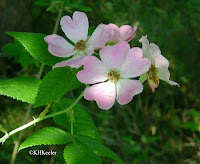 |
| Nasturtium officinale NOT Nasturtium nasturtium-aquaticum |
Who makes the rules for plant names?
The answer is: The International Association of Plant Taxonomists (IAPT) (home page).
 |
| Tropaeolum, determined to be sufficiently different from other plants that it is the only genus in family Tropaeolaceae |
Like all of science, it is a human activity. Like all human activities, therefore, it is subject to quirky human behavior.
(Disclosure: I am a plant ecologist not a plant taxonomist. I am a user of plant names, not a maker of orderly plant names. I confess I sometimes find the debates of taxonomists puzzling or amusing.)
There are well over 400 families of plants subject to the IAPT's naming rules. A coherent system for the names of families was obviously going to be very helpful. So a system was proposed: each family was to be named by adding -ceae to a genus in the family. Thus. the rose family, Rosaceae, is named for the genus Rosa and the Ulmaceae for Ulmus, elms.
 |
| a rose, genus Rosa, rose family, Rosaceae |
The families with two names are:
the carrot family, Apiaceae, traditionally called the Umbelliferae;
the palms, Arecaceae, traditionally Palmae;
the sunflower family, Asteraceae, traditionally called the Compositae;
the mustards, Brassicaceae, traditionally Cruciferae;
the clusia family, Clusiaceae, traditionally Guttiferae;
the grass family, Poaceae, traditionally called Gramineae; the pea famly, Fabaceae, traditionally Leguminosae, and
the mint family, Lamiaceae, traditionally called Labiatae.
To read the formal language on families go to: International Code of Nomenclature for algae, fungi, and plants Sect. 18 http://www.iapt-taxon.org/nomen/main.php?page=art18. This agreement was reaffirmed by the Eighteenth International Botanical Congress in Melbourne, Australia, July 2011, called the Melbourne Code.
palms, Palmae, palm family
|
palms, Arecaeae, palm family
|
For these families, both family names are correct, use the one you prefer.
People learning the plant families for the first time find the system odd, since they can comfortably learn Arecaceae and Brassicaceae and most of them have no stake in the old names.
In defense of the old names, I should note that they tend to be descriptive: Umbelliferae describes the shape of the flowers in the family (umbels), Palmae is obviously descriptive compared to Arecaceae, Compositae refers to the compound (composite) flowers in the family, Cruciferae the cross-shaped (4-petal) flowers of mustards, etc.
Functionally, this ongoing compromise means that in an alphabetized list of plant families, if you can’t find the carrot or dill in the A’s (Apiaceae), look under U (Umbelliferae), and if the sunflowers aren’t under A, check C (Compositae).
It also makes it just a bit harder to recognize a family name. If it is capitalized and ends in -ceae, then it is the name of a plant family. But the older family names end in -ae. I do not think there are genera or species that end in ae, so -ae or -eae clues you to the fact it is a higher category, in fact, a family, but it is not as clear as seeing -ceae.
<to be continued in next post: Botany Rules 5: New Rules and Ongoing Discussion >


No comments:
Post a Comment